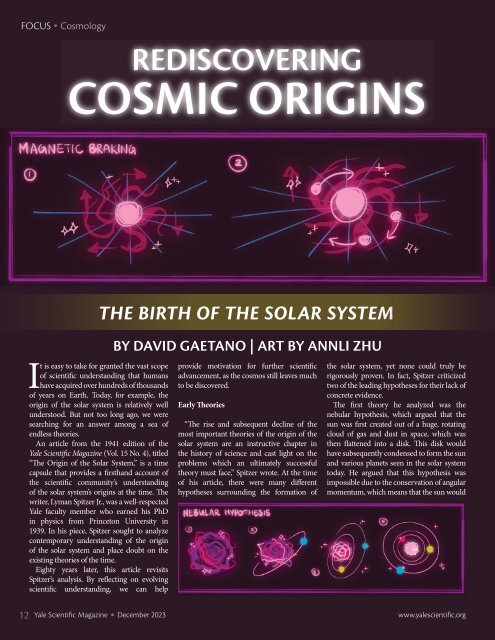YSM Issue 96.4
You also want an ePaper? Increase the reach of your titles
YUMPU automatically turns print PDFs into web optimized ePapers that Google loves.
FOCUS<br />
Cosmology<br />
REDISCOVERING<br />
COSMIC ORIGINS<br />
THE BIRTH OF THE SOLAR SYSTEM<br />
BY DAVID GAETANO | ART BY ANNLI ZHU<br />
It is easy to take for granted the vast scope<br />
of scientific understanding that humans<br />
have acquired over hundreds of thousands<br />
of years on Earth. Today, for example, the<br />
origin of the solar system is relatively well<br />
understood. But not too long ago, we were<br />
searching for an answer among a sea of<br />
endless theories.<br />
An article from the 1941 edition of the<br />
Yale Scientific Magazine (Vol. 15 No. 4), titled<br />
“The Origin of the Solar System,” is a time<br />
capsule that provides a firsthand account of<br />
the scientific community’s understanding<br />
of the solar system’s origins at the time. The<br />
writer, Lyman Spitzer Jr., was a well-respected<br />
Yale faculty member who earned his PhD<br />
in physics from Princeton University in<br />
1939. In his piece, Spitzer sought to analyze<br />
contemporary understanding of the origin<br />
of the solar system and place doubt on the<br />
existing theories of the time.<br />
Eighty years later, this article revisits<br />
Spitzer’s analysis. By reflecting on evolving<br />
scientific understanding, we can help<br />
provide motivation for further scientific<br />
advancement, as the cosmos still leaves much<br />
to be discovered.<br />
Early Theories<br />
“The rise and subsequent decline of the<br />
most important theories of the origin of the<br />
solar system are an instructive chapter in<br />
the history of science and cast light on the<br />
problems which an ultimately successful<br />
theory must face,” Spitzer wrote. At the time<br />
of his article, there were many different<br />
hypotheses surrounding the formation of<br />
the solar system, yet none could truly be<br />
rigorously proven. In fact, Spitzer criticized<br />
two of the leading hypotheses for their lack of<br />
concrete evidence.<br />
The first theory he analyzed was the<br />
nebular hypothesis, which argued that the<br />
sun was first created out of a huge, rotating<br />
cloud of gas and dust in space, which was<br />
then flattened into a disk. This disk would<br />
have subsequently condensed to form the sun<br />
and various planets seen in the solar system<br />
today. He argued that this hypothesis was<br />
impossible due to the conservation of angular<br />
momentum, which means that the sun would<br />
12 Yale Scientific Magazine December 2023 www.yalescientific.org

















